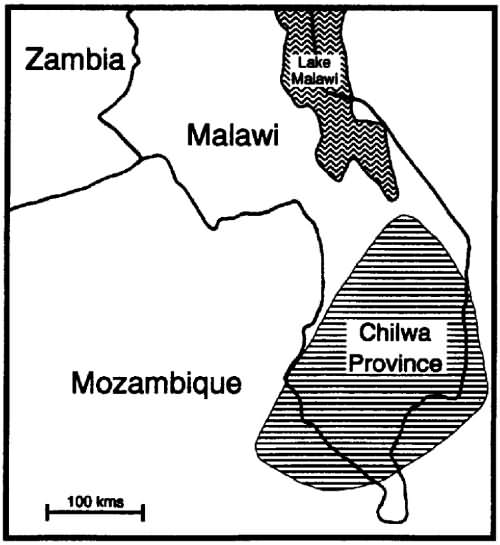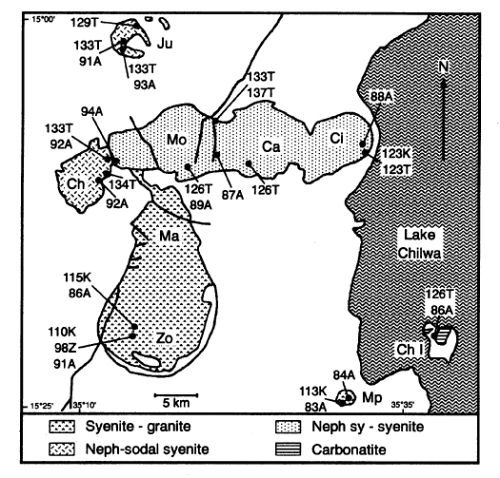 U. Mass Lowell
U. Mass Lowell |
Prof. Nelson Eby | Department of Environmental, Earth, & Atmospheric Sciences |
|
Chilwa Alkaline Province, Malawi |
|
The Cretaceous Chilwa alkaline province of southern Malawi (Figure 1) has an exceptional variety of lithologies ranging from carbonatite to granite (Figure 2). The largest plutons consist of syenite and peralkaline granite [Zomba (Zo) and Malosa (Ma)], with somewhat smaller intrusions consisting of syenite [Chaone (Ca) and Chikala (Cl)], nepheline syenite [Chinduzi (Ch) and Monglolowe (Mo)] and sodalite syenite [Junguni (Ju)]. Carbonatite and minor nephelinite occur on Chilwa Island (Ch), and metamorphosed basanitic/nephelinitic volcanics are preserved in down-faulted blocks. Radiometric age determinations indicate a sequence of emplacement of the intrusions that starts with the strongly silica-undersaturated syenites and nephelinites and ends with the silica-saturated to silica over-saturated syenites and alkali granites of Zomba Mountain. |
|
 |
 |
| Figure 1. Location map for the Chilwa alkaline province (CAP). |
Figure 2. Map of the intrusions of the northern part of the CAP. Also shown are various radiometric ages. See Eby et al. (1995) for further details. |
|
The present study builds on earlier work by Woolley, Platt, and others. The focus is on the petrology, geochemistry (INAA trace elements), geochronology (fission track), and isotope geology. The principal collaborator is Alan Woolley, Natural History Museum. Other collaborators are Mary Roden-Tice, SUNY Plattsburg; Beth Herling and Wade Ewing, University of Massachusetts Lowell; Garth Platt, Lakehead University; and Ken Collerson, University of Queensland. Publications resulting from the present study and pictures of the field area are found below. |
|
|
|
|
Eby, G. N. Alkaline rocks comprise a minor amount of the total volume of igneous rocks, but in terms of variety and complexity they have challenged petrologic thinking for decades. Alkaline magmatism is widely distributed both spatially and throughout geologic time. Most alkaline provinces show significant lithological diversity and classic examples of this diversity are the Chilwa Alkaline Province (CAP) of southern Malawi and the Monteregian Hills - White Mountain (MHWM) province of Quebec and New England. CAP magmatism started at ca 133 Ma and continued to ca 110 Ma. Initial magmatism was marked by the eruption of nephelinitic and basanitic magmas (now preserved as large enclaves in later syenite intrusions). Subsequent intrusions systematically progressed from silica undersaturated sodalite-nepheline syenites through syenites, and the igneous activity culminated with the emplacement of a large alkali granite body. Spatially related carbonatite magmatism occurred ca 126 Ma. Sr, Nd, and Pb isotopic data show that the magmas were all derived from a depleted mantle source with OIB-like characteristics. Both trace element and isotopic data support the contention that the trend towards silica oversaturation was largely due to greater amounts of crustal contamination, probably a reflection of both a longer residence time for the melts in the deep crust and an increase in crustal temperatures because of the earlier igneous activity. In contrast to the CAP, the bulk of the igneous activity in the MHWM occurred at ca 123 Ma and ithologic diversity is spatially distributed - carbonatites occur at the western end of the province and eastward the plutons become less silica undersaturated. Plutons emplaced into the folded Appalachian sequence are largely composed of silica saturated to silica oversaturated lithologies. There is a general increase in the volume of the plutons in an easterly direction. In terms of areal exposure felsic rocks are more abundant than mafic rocks, but geophysical data indicate that there are significant volumes of mafic rock at depth. With the exception of the carbonatites, throughout the province both mafic and felsic rocks show trace element distributions characteristic of OIBs. Both trace element and isotopic data support the derivation of the melts from an OIB-like source. Melting models suggest that in an easterly direction there is an increase in partial melting in the source region, and this is the most important parameter in determining the silica undersaturated or silica saturated characteristics of individual plutons. A secondary effect is interaction of the melts with crustal material. The Chilwa Alkaline Province, Malawi - Geochemistry, Isotope Geology, and Petrogenesis Eby, G. N., Woolley, A. R., and Collerson, K.
The
Cretaceous Chilwa alkaline province lies at the southern end of the
East African rift system. A diverse suite of intrusive and extrusive
alkaline igneous rocks is found in the province. The earliest igneous
activity (ca 133 Ma) is
represented by the extrusion of nephelinites and basanites and the
intrusion of nepheline and sodalite syenites.and carbonatite.
Nepheline syenites and syenites were subsequently intruded ca 126 Ma followed by the emplacement of large peralkaline syenite-granite
intrusions ca 113 Ma (Eby et
al., 1995). Trace element and Sr and Nd isotopic data have been
determined for a subset of the samples reported in Woolley and Jones
(1987). OIB-normalized spider diagrams for the basanites are essentially flat with absolute abundances of 1 to 2x OIB. The nephelinites show a more irregular pattern with relative enrichment in LIL elements (3-5x). OIB-normalized spider diagrams for the phonolites, syenites, and granites are generally flat to slightly LIL-enriched with absolute abundances of 1-10x OIB and significant negative Ba, Sr, P, and Ti anomalies. Two groups of phonolites can be identified based on REE patterns – one shows no relative Eu depletion (Group I) while the other shows significant Eu depletion (Group II).
In
terms of Sr and Nd isotopes the basanitic volcanics and the
nephelinites of Chilwa Island have depleted mantle signatures. The
strongly nepheline-normative syenites also show depleted mantle
signatures. The syenites and granites show evidence of crustal
contamination that can generally be explained by simple mixing with
crustal material. The two phonolite groups are isotopically distinct
– Group I has low Sr initial ratios while Group II has high Sr
initial ratios.
The
basanites and nephelinites can be generated by small percentage melts
of a trace-element enriched mantle source (but significant relative
LIL-enrichment is not required). The isotopic and trace element data
are consistent with the evolution of the Group I phonolites at great
depth, where plagioclase crystallization was suppressed, while the
Group II phonolites evolved by assimilation-fractional crystallization
(AFC) processes at shallow depth. The transition from silica-undersaturated
syenites to silica-saturated syenites and granites is probably the
result of melting and assimilation processes occurring at the base of
the crust. AFC processes, during emplacement at high levels, are
responsible for subsequent minor variations in magma chemistry. |
|
Geochronology and Cooling History of the Northern Part of the Chilwa Alkaline Province, Malawi Eby, G. N., Roden-Tice, M., Krueger, H. L, Ewing, H. L., Faxon, E. H., and Woolley, A. R. The Cretaceous Chilwa alkaline province of southern Malawi has an exceptional variety of lithologies ranging from carbonatite to granite. The largest plutons consist of syenite and peralkaline granite, with somewhat smaller intrusions consisting of syenite, nepheline syenite and sodalite syenite. Carbonatite and minor nephelinite occurs on Chilwa Island, and metamorphosed basanitic/nephelinitic volcanics are preserved in down-faulted blocks. K-Ar amphibole and titanite fission-track ages were determined for all of the major plutons, and from these ages emplacement times were estimated for the various plutons (Fig. 2). Apatite fission-track ages and confined track-length measurements in apatite were determined in order to develop a thermal model for the Chilwa province. K-Ar amphibole and titanite fission-track ages indicate that igneous activity started ca 133 Ma with the extrusion of nephelinitic lavas and the emplacement of nepheline and sodalite syenites. An existing K-Ar date for the carbonatite at Chilwa Island gives a similar age. Nepheline syenites and syenites were intruded ca 126 Ma followed by the emplacement of large syenite-peralkaline granite plutons ca 113 Ma. The geochronology suggests that there was a temporal variation in the chemistry of the magmas forming the Chilwa plutons. Apatite fission-track ages and track length measurements indicate that the intrusions were emplaced at high level (shallow burial depths) and cooled relatively rapidly to near ambient temperatures. The emplacement of the large syenite-granite pluton (Zomba-Malosa) caused local doming which led to a rapid exhumation rate for Zomba-Malosa. Plutons distal to Zomba-Malosa show a slower cooling rate suggesting that they were on the flanks of the local uplift and more deeply buried. The Chilwa alkaline magmatism postdates the Karoo volcanism and has no apparent direct relationship to the Karoo magmatism. It seems most likely that the Chilwa magmatism was caused by crustal extension which ruptured pre-existing zones of weakness leading to decompression melting. |
|
Photographs of the field area in southern Malawi |